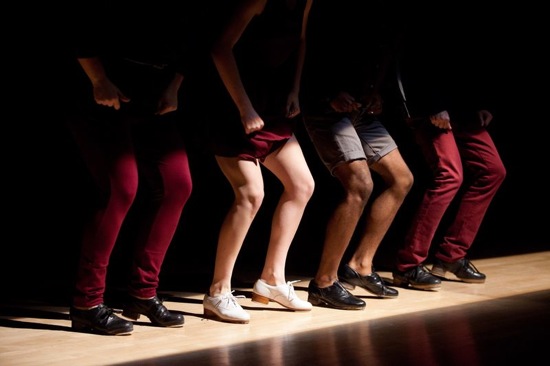
The feet have it. Dorrance Dance/New York. Photo: Matthew Murphy
Silence doesn’t play a large role in Michelle Dorrance’s SOUNDspace. In the Danspace performances of Dorrance Dance/New York, the choreographer treats St. Mark’s Church as an acoustic instrument, and the building is happy to comply. Back in 1795, when its cornerstone was laid, ministers had no microphones, and the voices of parishioners hymning their lungs out could make it seem as if the high vaulted ceiling overhead was merely a stop on the way to heaven.
To a tap artist like Dorrance, resonance goes hand in hand with rhythm, and a fine wooden floor (rare in New York performing spaces now) is a sounding board to be cherished. She prepares us well by starting the evening in the dark. We hear feet—now here, now there—clacking along up in the balcony that surrounds the space on three sides, muted on the carpet behind us, scraping on a gritty surface like sand.
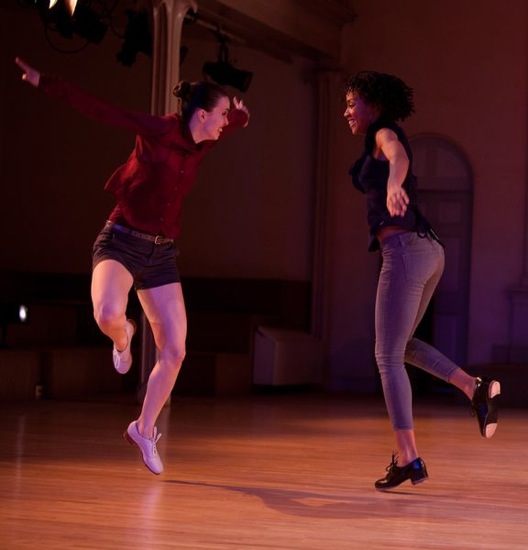
Michelle Dorrance and Karida Griffith dialogue. Photo: Matthew Murphey
Dorrance has engineered the audio component of SOUNDspace beautifully. Her eight dancers, attractively garbed in combinations of crimson, navy blue, and gray, begin in stocking feet, work up to soft shoes, graduate to footwear equipped with wooden taps, and end up quiet again. From the outset, Dorrance deploys them skillfully in space—now pitting four against two, setting a group circling a soloist, having two trios crisscross, building counterpoint. The stage picture keeps shifting as dancers come and go, take over the space, and cede it. She makes her own first appearance passing back and forth through an advancing rank of others.
When the dancers are wearing socks, they make a thing of sliding their feet—a barely audible sound. Mild imprecision is a given, stopping on a dime not always possible. Dorrance performs her very on-a-dime solo in jazz shoes. She’s a beguiling performer—cheerful, gangling, hunkering down a little into her intrepid footwork. At first, it’s the toes that you hear—light and delicate—then she starts dropping her heels for emphasis. When Warren Craft has finished his strong soft-shoe solo on the main floor, he’s confronted by tall Ryan Casey facing him from the carpeted altar steps, and the two have a little dialogue in their two different “voices” before Casey takes his own quiet-footed solo.
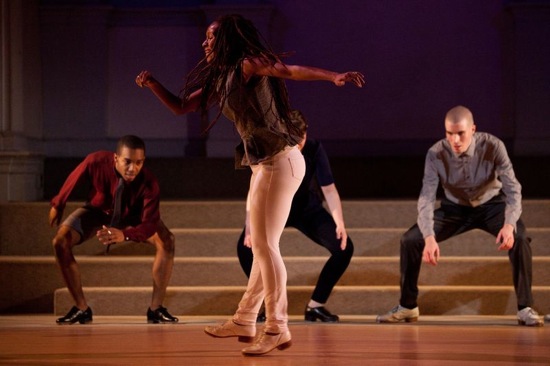
Dormeshia Sumbry-Edwards shows her stuff. Identifiable at back: Byron Tittle (L.) and Warren Craft. Photo: Matthew Murphy
The audience is hot and knowledgeable; they whoop for joy. When Megan Bartula, Demi Remick, Karida Griffith, and Aska Shiozawa pass rhythms down a line and then—akimbo elbows just touching—exit in sort of shuffle-off-to-Buffalo line, they’re cheered. The dancers radiate conviviality. When the great Dormeshia Sumbry-Edwards joins in about a third of a way through the performance, Dorrance and Griffith move to the sidelines and, grinning, patter a quiet rhythm accompaniment, their eyes trained on her. Metal isn’t allowed on St. Marks’ floor, and the tappers’s shoes now bear carefully cut wooden slabs, like those used before metal ones became the standard. Sumbry-Edwards, a marvel of precise rhythms and energetic finesse, makes wood meet wood and fall in love.
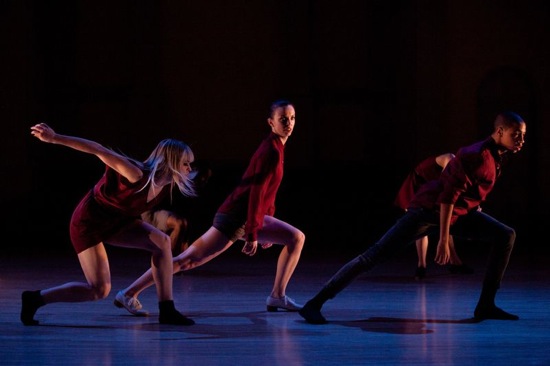
(L to R): Mishay Petronelli, Michelle Dorrance, and Jose “Boi Boy” Tena. Photo: Matthew Murphy
As the piece develops, other interesting things happen. Greg Richardson appears with a double bass, and adds its subtle voice to the percussive games. Mishay Petronelli and Jose “Boy Boi” Tena drop in, both in socks. He’s only 18 and she, though experienced, might well be his playful date for the prom. They come equipped with some hip-hop moves (tastefully integrated into the texture of the piece) and tend to travel more in space. Whoosh, there goes one of his long, slim legs, kicking over his partner’s head as she ducks. Craft and Elizabeth Burke step into sand boxes on the far corners of the church’s risers and scrape out a new sound. Nicholas Young performs his own virtuoso exercise in body percussion—building music through slaps, claps, and stamps on different resonant surfaces.
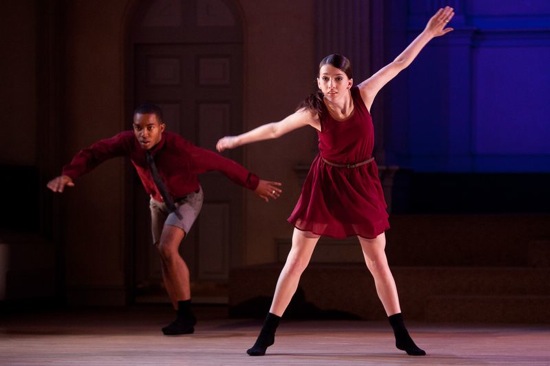
Demi Remick (front) and Byron Tittle. Photo: Matthew Murphy
Dorrance, aided by Kathy Kaufman’s spare, elegant lighting effects, builds the evening beautifully, adding elements, devising new spatial patterns presenting the dancers in various combinations (these include Byron Tittle, whom I haven’t mentioned yet). Socks reappear on some performers. Three-part counterpoint erupts into delirious complexity. And suddenly, Craft, Casey, and Shiozawa are dancing barefoot.
At the end, the audience explodes to its feet. I mean, explodes. Such clapping! Such yelling! Such whooping! Every bit of it deserved.
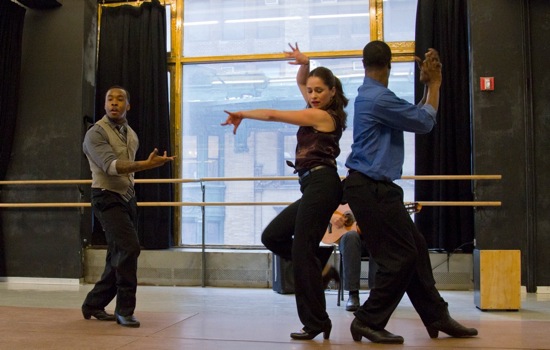
(L to R): Gene Seals, Noellia Garcia Carmena, and Shamar Rooks of Memphis’s New Ballet Ensemble and School. Photo: Nicolette Overton
During the week that the Association of Performing Arts Presenters (APAP) took over the town, almost every small and medium-sized company you ever heard of and many unfamiliar ones were on view somewhere between 9:30 in the morning and late at night. In Studio 1C at the Joan Weill Center, one of the Ailey school’s classes ended around 4:00 P.M., the staff set up chairs, and between 4:10 and 4:50, the New Ballet Ensemble and School from Memphis, Tennessee, presented, twice, one of its three New York showcases.
If you have ever googled “Lil Buck,” you will know that a YouTube video of him performing The Swan, accompanied on the cello by Yo-Yo Ma, at the opening of the 2011 Vaill Festival has received over two million hits (http://www.youtube.com/watch?v=C9jghLeYufQ). Well it’s Katie Smythe, CEO and artistic director of Memphis’s New Ballet Ensemble and School, who suggested to the young whiz at Memphis jookin to improvise to Saint-Saëns’ The Swan (introducing the school’s students to classical music has been part of Smythe’s mission).
All the pupils study ballet, but, recognizing the heterogeneous population of Memphis, Smythe added classes in African, Flamenco, Hip Hop, modern dance, and Chinese dance. At the Ensemble’s two back-to-back showcases in the Ailey studio, none of the tutus-and-pointe-shoes works that figure in the repertory are on view.
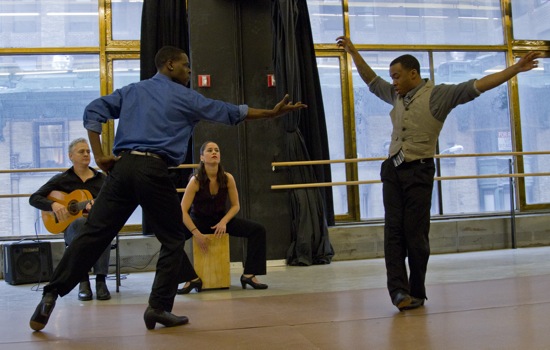
Gene Seals and Shamar Rooks in El Rey de Harlem. At back: Noellia Garcia Carmena and guitarist Ray Brewer. Photo: Nicolette Overton
El Rey de Harlem, gives the word “hybrid” a new gloss. The title comes from one of the poems Federico Garcia Lorca wrote during his stay in New York (“. . .Ay Harlem!/ No anguish can compare to your crushed reds,/. . .to your great king, a prisoner in a doorman’s uniform.”). However, this dance is more about character and style than about violence. While Roy Brewer plays guitar, two spruce young men, Gene Seals and Shamar Rooks, dance contentiously with each other and with the choreographer Noellia Garcia Carmena, a flamenco dancer who teaches at the school. Anyone temporarily not dancing creates rhythms on a beatbox.
For the men, this is flamenco mated with hip-hop. They both have the turkey-cock pride and the percussive feet of the flamenco dancer, but the Spanish style’s flourishing wrists morphs into arms that ripple and necks that jut out in circles. The guys face off but their hands don’t touch. Seals evades Rooks by means of a cartwheel. Garcia Carmena intervenes, incites them to whirl. Her expert solo is pure flamenco, but toned down. Seals shows off for her with some b-boying moves, Rooks with a complicated slithering and twisting and twining of his arms. The three are not at all alike, but they dance in unison, sharing what works for all.
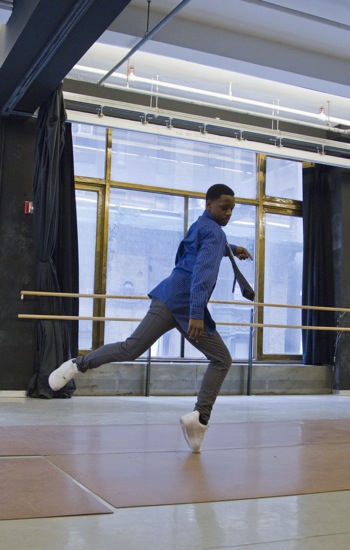
TJ Benson performs The Swan. Photo: Nicolette Overton
After that, to a recording, 14-year-old TJ Benson dances The Swan. The solo is improvised, but it follows the structure of Mikhail Fokine’s The Dying Swan. This teenager, too, has performed it with Yo-Yo Ma, when the great cellist appeared with members of the Memphis Symphony to accompany a recital by the New Ballet students. In jookin, the dancer’s hands, arms, shoulders, and neck draw fluid spirals and circles and shrugs close around his body. Benson slides his feet along the floor as swimmingly as any swan, turning a leg in and out, rising onto his toes in his sneakers, arching his back as if it were a long neck. Without the required straight legs of ballet, his liquid turns on point rise and sink seamlessly down.
His performance is very musical and downplays some of the showy stuff that Lil Buck ventures into. At the end, he convulses slightly, as if spitting out his life, and sinks down into the final position that ballerinas assume—taking a moment to arrange himself for death.
I had to leave, but I’d have been happy to see the performance all over again.

Many thanks to Ms. Jowitt and others who attended our performances at APAP. There was so much dance to see in those few days, that we are humbled to have had wonderful audiences.
Please note that Gene Seals is the dancer referred to as “Fields” (likely my little bit of southern accent at issue here). Seals entered the New Ballet School in Memphis on scholarship simultaneous with Lil Buck (Charles Riley). He adds more breaking moves to his jookin improvisations and has been a diligent student of ballet and flamenco for five years. He grew up with Riley as friends and partners in dance, frequently improvising and setting dance battles within other works. Noelia Garcia Camona was a founding member of Increpacion Danza. Readers can discover more about her background by visiting this web site. We love this company! http://www.increpacion.com/